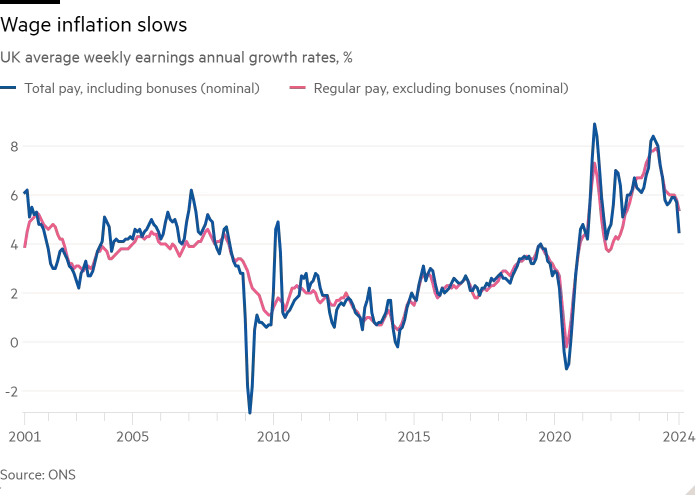UK wage growth hits lowest rate in two years

(Photo credit: Bloomberg)
Source: Financial Times
UK wage growth slowed to the lowest rate in almost two years in the three months to June, though the unemployment rate unexpectedly fell, according to official data released on Tuesday.
Annual earnings growth, excluding bonuses, slowed to 5.4 per cent from a revised 5.8 per cent in the three months to May, the Office for National Statistics said.
This was in line with forecasts by economists polled by Reuters and marked the lowest level since July 2022.
“The further easing in wage growth will be welcomed by the Bank of England as a sign that labour market conditions are continuing to cool,” said Ruth Gregory, economist at consultancy Capital Economics.
“This lends some support to our forecast that the Bank of England will press ahead with two more 25 bps interest rate cuts later this year,” she added.
The statistics agency also reported that the UK unemployment rate declined to 4.2 per cent in the three months to June from 4.4 per cent in the three months to May. Economists had forecast an increase to 4.5 per cent.
The figure, which suggests a hotter labour market, conflicts with the cooling implied by the wage growth data.
However, analysts noted that the unemployment data is unreliable due to low response rates to the survey from which it is derived. That survey is separate from that used for the wage data.
Gregory said:
“Given the problems with the labour force survey, it is difficult to know how much weight we should place on these figures — perhaps not too much.”
Rob Wood, economist at consultancy Pantheon Macroeconomics, added that the BoE’s Monetary Policy Committee would place “relatively little weight” on the employment data.

However, he said that the recent recovery in economic growth and rebounding payroll employment — which rose by 24,000 in early estimates for July — suggest the labour market might not be slowing.
“All told, we think rate-setters will struggle to justify back-to-back interest rate cuts with jobs growth looking robust,” he said, referring to the possibility of the BoE lowering borrowing costs at its meeting in September. “We expect the MPC to wait until November to cut the bank rate again.”
Sterling rallied after the data was released, increasing 0.23 per cent on the dollar to trade at $1.28.
Investors scaled back interest rate expectations slightly, continuing to price in one rate cut in November but attributing a lower probability to a second reduction in December.
Members of the MPC closely monitor wage growth as a key indicator of domestic price pressures and inflation.
The BoE focuses particularly on private sector pay growth, for which it had forecast a slowdown to 5.1 per cent in the three months to June.
The ONS data was broadly in line with the those expectations, with annual average regular earnings growth in the private sector slowing to 5.2 per cent in April to June 2024, the lowest level in more than two years.
The BoE cut interest rates for the first time since the pandemic by a quarter of a percentage point to 5 per cent on August 1, but investors expect it will hold its benchmark rate steady in September.
The latest figures come ahead of Wednesday’s UK inflation data for July, which is expected to show price growth rising back above the BoE’s 2 per cent target to 2.3 per cent, in part due to reduced drag from household energy bills.
Annual pay growth including bonuses slowed to 4.5 per cent from 5.7 per cent over the same period, in part due to a one-off payment to NHS staff in June 2023 that was not repeated this year.
The ONS also reported that the employment rate, which is also based on the labour market survey, was broadly unchanged at 74.5 per cent in the quarter, down 1.7 percentage points from pre-pandemic levels.
Chancellor Rachel Reeves said:
“Today’s figures show there is more to do in supporting people into employment because if you can work, you should work.”
